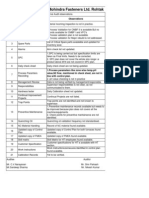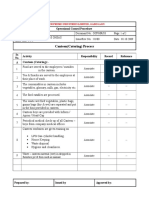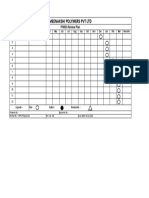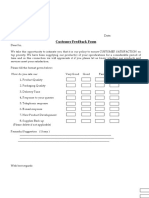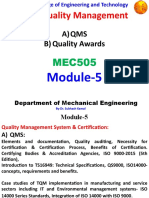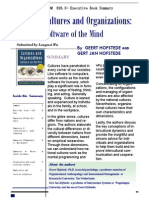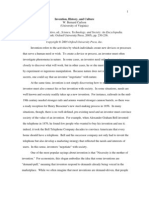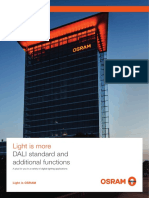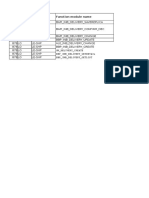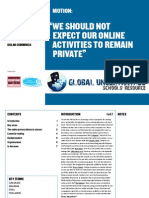Professional Documents
Culture Documents
Thyssenkrupp - Supplier Rating PDF
Uploaded by
mihaichfOriginal Title
Copyright
Available Formats
Share this document
Did you find this document useful?
Is this content inappropriate?
Report this DocumentCopyright:
Available Formats
Thyssenkrupp - Supplier Rating PDF
Uploaded by
mihaichfCopyright:
Available Formats
Title Supplier Rating
Code CD-00030-EN
Previous Code CD-030-EN
Version 4
Document type EN\Corporate Document
Status
CD-00030-EN, Version: 4 Originator: F. Pfitzenmaier/QCE 1 / 18
Validity date 05.03.2010
Attention Print-outs are uncontrolled and for reference only.
Remark concerning document language
In case an original edition in the editors native language exists, the interpretation of this
original edition is valid.
Abstract:
This document describes the supplier rating for all divisions at TKT-Presta.
This document is an English translation from the German original. In case of any translation concern
please refer to the original German version for validity.
The copyright of this document and all supplements remain to TKT-Presta. It is strictly prohibited to make copy
of it and to inform or make accessible to a third party without a written authorization from TKT-Presta.
CD-00030-EN, Version: 4 Originator: F. Pfitzenmaier/QCE 2 / 18
0 Change History
Version Date Modified by Description of the modification
1.0 creation
Chapter 3; Revision of classification for audit result, Definition of
responsibility for Data collection
2.0 Change of ppm-target
Revision of supplier rating manual
Revision of attachment
Point 5: Logistics process instead of the shipping instructions.
3.0
Point 7: TKT requirement QT-003 added
Point 2: Table 3 (Responsibility for the Data Management of the
several criteria) integrated.
Point 4: Table 6 (Rating of incoming inspection) modified and
supplemented.
4.0 04.11.09 F. Fitzenmaier
Point 6: Actions, Measures and Escalation supplemented. Table
14 (status, violations, actions etc.) from point 2 integrated,
adjusted and defined
Document in a WORD-template integrated.
Documents to apply
No. Authors Title
CD-00030-EN, Version: 4 Originator: F. Pfitzenmaier/QCE 3 / 18
Table of Content
Supplier Rating ...........................................................................................................1
0 Change History ...........................................................................................................3
1 Scope ........................................................................................................................6
2 Introduction ................................................................................................................6
2.1 Objective.............................................................................................................6
2.2 Terms and definitions ...........................................................................................7
2.3 Criteria, targets and period under consideration.......................................................7
2.4 Supplier status, violations and actions of supplier and TKT-Presta .............................7
2.5 Responsibilities ....................................................................................................8
3 Rating of the criteria QM-System and Audit (Category System) .........................................9
3.1 QM-System .........................................................................................................9
3.2 Audit ................................................................................................................10
4 Rating of the criteria Incoming inspection and ppm (Category Quality) .............................10
4.1 Incoming inspection ...........................................................................................10
4.2 ppm .................................................................................................................11
5 Rating of the criterions Up-to-schedule shippings and Logistics process (Category Logistics)12
5.1 Up-to-schedule shippings ...................................................................................12
5.2 Logistics process ...............................................................................................13
5.2.1 Evaluation of the inbound process.................................................................13
5.3 Evaluation of the communication behaviour...........................................................14
6 Actions, Measures and Escalation ...............................................................................14
6.1 Events or rather occurrences which could lead to an escalation level, are:.................17
6.1.1 Violation of trust..........................................................................................17
6.1.2 Field actions at the customer ........................................................................18
6.1.3 Line shutdowns...........................................................................................18
6.1.4 Indoor breakdowns......................................................................................18
7 Records retention ......................................................................................................18
8 References ...............................................................................................................18
CD-00030-EN, Version: 4 Originator: F. Pfitzenmaier/QCE 4 / 18
List of Tables
Table 1: Terms and definitions............................................................................................7
Table 2: Criteria, targets and period under consideration .......................................................7
Table 3: Responsibilities.....................................................................................................8
Table 4: Point rating QM-System.........................................................................................9
Table 5: Point rating Audit ................................................................................................ 10
Table 6: Point rating incoming inspection ........................................................................... 11
Table 7: Point rating ppm-value ........................................................................................ 11
Table 8: Point conversion up to schedule shipping .............................................................. 12
Table 9: Manual point conversion up to schedule shipping ................................................... 12
Table 10: Total deduction logistics process ........................................................................ 13
Table 11: Total deduction inbound process ........................................................................ 13
Table 12: Deduction points based on logistics complaints .................................................... 14
Table 13: Total deduction communication behaviour ........................................................... 14
Table 14: Definition of the escalation rating ........................................................................ 15
Table 15: Participant and their responsibilities in the escalation management meeting ............ 16
Table 16: Records retention.............................................................................................. 18
CD-00030-EN, Version: 4 Originator: F. Pfitzenmaier/QCE 5 / 18
1 Scope
This CD is valid for all plants of ThyssenKrupp Presta and for all suppliers of serial production.
2 Introduction
2.1 Objective
In conjunction with its suppliers, ThyssenKrupp Presta (hereinafter TKT-Presta) is continuously
striving to optimize its material and information flow.
The supplier rating serves as a controlling tool for both the supplier and TKT Presta, and thus
helps to continually improve and further develop customer-supplier relationships.
The main points of the supplier rating are:
to communicate goals for all 6 rating-criterions (target state);
to present the actual status and deviation to target state of the supplier relationship via
the TKT-Presta Supplier Portal every month;
to realize closed-loop-control between TKT-Presta and their suppliers (elimination of
deviations between actual and target state)
to continuously improve the quality of the delivered products;
to guide suppliers to the 0 ppm-goal
to achieve the QM-system prerequisites required by TKT Presta;
to realize a stable long-term supplier relationship
to provide a clear overview of the suppliers logistics services;
to ensure that suppliers focus on those aspects of logistics that are important for TKT
Presta;
and to reduce the occurrence of failures in the supply process.
The terms, consequences, actions, responsibilities, formula and basic information for the
supplier rating are explained in this manual. Any specific questions should be addressed to the
responsible Division Purchasing department of TKT-Presta.
CD-00030-EN, Version: 4 Originator: F. Pfitzenmaier/QCE 6 / 18
2.2 Terms and definitions
Rating Each month the supplier receives a rating for all criteria that have been evaluated, whereby
100 points are the highest possible rating, and one point is the worst value.
Target For each criterion a minimum score is defined as target. Targets will be verified periodically
and defined for the next fiscal year.
Violation Every month the supplier misses the target results in a target violation.
Period under To determine the supplier status only violations during the period of consideration are
consideration recorded. There are different periods of consideration for several criterions.
Supplier status Traffic light symbols and additional items indicate the supplier status. The displayed supplier
status leads to actions of supplier and TKT-Presta.
Table 1: Terms and definitions
2.3 Criteria, targets and period under consideration
The evaluation is based on six criteria which are dedicated to three categories.
Category Criterion Target Period under
consideration
System QM System >= 50 6 month
System Audit (result) >= 71 6 month
Quality Incoming Inspection >= 90 12 month
Quality PPM >= 50 (is equivalent to 12 month
50 ppm)
Logistics Up-to-schedule Shippings >= 90 6 month
Logistics Logistics process >= 90 6 month
Table 2: Criteria, targets and period under consideration
A detailed description of the individual criteria is given at a later time.
2.4 Supplier status, violations and actions of supplier and TKT-Presta
The rating of the preceding month is shown on the supplier portal on the 15th of each month.
It is possible that rating data of previous months change due to information arisen after the 15th.
CD-00030-EN, Version: 4 Originator: F. Pfitzenmaier/QCE 7 / 18
Detailed data
The magnifier symbol in the rating of the Supplier Portal is used to access the detail view of
the rating. Clicking on the glasses symbol displays the detail view of a specific material or the
total view of all materials. The detail views can only be called up for those locations for which the
data are automatically determined in SAP.
2.5 Responsibilities
Process definition of the Supplier Escalation Management
The responsible quality department in the division controls and carries out a monthly plausibility
check of the supplier rating. The responsible quality department organises and coordinates the
monthly Supplier Escalation Management Meeting, with number of participants
Center logistic department
Concerned commodity group buyer / purchasing manager
Quality representative of the plant if necessary
Technical specialist if necessary
In case of a grading in escalation level 1-3 the central purchasing manager has to inform the
commodity group buyer or rather the purchasing organisation of the concerned divisions.
Criteria Responsibility for the Data Management of the different criteria
QM-System Purchase controlling TKT-Presta Eschen
Audit Performing auditor TKT-Presta Eschen
Incoming Inspection Responsible Quality Engineer (QB) of the concerned plant
PPM Responsible Quality Engineer (QB) of the concerned plant
Up-to-schedule Shippings Responsible Logistic Manager of the concerned plant
Logistics process Responsible Logistic Manager of the concerned plant
Table 3: Responsibilities
CD-00030-EN, Version: 4 Originator: F. Pfitzenmaier/QCE 8 / 18
3 Rating of the criteria QM-System and Audit (Category
System)
3.1 QM-System
The rating criterion QM-System considers the quality and environmental management system of
the supplier. The quality and environmental management system has to be accepted and
certified by an independent third-party (e.g. certification according to ISO TS16949, ISO14001,
etc.).
Table 4 explains the rating and the corresponding number of points.
QM-System of supplier Point rating
ISO TS 16949 or VDA 6.1 and ISO 14001 100 points
ISO TS 16949 or VDA 6.1 90 points
ISO 9001 and ISO 14001 70 points
ISO 9001 50 points
ISO 14001 30 points
Not fulfilled 1 point
Table 4: Point rating QM-System
The purchase controlling at TKT-Presta Eschen is responsible for data management in SAP.
CD-00030-EN, Version: 4 Originator: F. Pfitzenmaier/QCE 9 / 18
3.2 Audit
The rating criterion TKT Presta Audit is the result of the audit carried out by TKT Presta
employees on the vendors premises. The rating is equivalent to the level of compliance (audit)
according to CD-008 shown in table 5.
(Ratings based on audits processed according to the old classification are valid till next audit.)
Level of compliance (audit) Rating Point rating
92 - 100 % A 92 - 100 points
71 - 91 % B 71 - 91 points
< 71 % C < 71 points
Table 5: Point rating Audit
The Performing auditor at TKT-Presta Eschen is responsible for data management in SAP.
The Central Quality has to be informed by the TKT-Presta Group members about supplier audit
results (if available)
4 Rating of the criteria Incoming inspection and ppm
(Category Quality)
4.1 Incoming inspection
The rating criterion Incoming inspection refers to the existing usage decision. The usage decision
describes whether a release or a deviation has been assigned to a delivery, the delivery is
subject toreworking or sorting, or returns to the supplier (return shipment). The average monthly
rating is calculated from the average value of the existing usage decisions.
For example, four deliveries from a supplier are received at a TKT Presta Group location during
December. A release was effected for one of these deliveries, a deviation for another two, and a
return delivery for the fourth. The corresponding score is calculated using the ratings from Table
6 and the following formula:
Average= (1*100+2*80+1*1)/4=65.25
Because only whole numbers are displayed in the rating, this result is rounded up or down.
In the case of this example, the corresponding score is 65 points.
CD-00030-EN, Version: 4 Originator: F. Pfitzenmaier/QCE 10 / 18
Rating of incoming inspection Point rating
Release 100 points
Free with exception (inform. complaint) 80 points
Free with exception (official complaint) 50 points
Rework action 50 points
Sorting action 50 points
Return delivery 1 point
Table 6: Point rating incoming inspection
4.2 ppm
ppm is the abbreviation for parts per million. The number of defective parts of all deliveries is
extrapolated to one million parts
(number of defective components*1000000 /total delivery volume).
The ppm-value determines the rating for the criterion ppm. There is a reverted relation between
point rating of the criterion and the ppm-value in the range of 0 - 99 ppm. (The ppm-value and
the rating of the criterion added without units of measurement complement one another to the
value 100.) 0 ppm determine 100 points and 99 ppm determine 1 point. More than 99 ppm are
also evaluated with 1 point (table 7). Exceeding of the maximum ppm-value leads to a change of
the supplier status (according to table 14).
The four deliveries from the preceding example refer to a total delivery volume of 20,000 parts;
the number of defective parts is 35. The PPM number is calculated as follows:
PPM = (35*1000000)/20000= 1750
In this example, the supplier has a PPM number of 1750 and receives one point in accordance
with the table below.
ppm-value Point rating
0 ppm 100 points
1 - 99 ppm 99 - 1 points
> 99 ppm 1 point
Table 7: Point rating ppm-value
The supplier is obliged to inform the responsible quality person if the rating needs to be corrected.
CD-00030-EN, Version: 4 Originator: F. Pfitzenmaier/QCE 11 / 18
5 Rating of the criterions Up-to-schedule shippings and
Logistics process (Category Logistics)
5.1 Up-to-schedule shippings
The criterion Up-to-schedule shippings determine the reliability of a supplier in consideration of
schedules and quantities. It is based on a percentage number and is converted into points as
shown in Table 8:
Up-to-scheduleshippings in % Point conversion
1 % - 100 % 1 - 100 points
<1% 1 point
Table 8: Point conversion up to schedule shipping
The monthly rating is based on the average (arithmetic mean) of all Up-to-schedule shipping
assessments in the period. Each delivery position is evaluated in respect of the quantity on time
in proportion to the total quantity of the delivery:
Up-to-schedule quantity of the delivery
Up-to-schedule shippings of one delivery = --------------------------------------------------
Total quantity of the delivery
Background of the assessment is the receipt of goods at TKT-Presta and the corresponding
delivery scheduling. When pickup dates are displayed in the schedule, transit times are added for
the calculation in case of variable transit times with respective tolerances. Stipulations which
have not been confirmed with a new delivery schedule are not taken into account. They are also
not subject to subsequent reclamations. Tolerances in over shipment, early deliveries and late
deliveries can be determined by TKT-Presta for different reasons. In case of an over shipment,
the tolerated quantity is subtracted from the total quantity in the formula above.
The described automatic rating has not yet been introduced in all TKT-Presta plants. At plants
where evaluation is performed manually, each delivery is evaluated according to the following
scheme (Table 9):
Delivery up-to-schedule Correct delivery quantities Complianc
e
Delivery up-to-schedule Quantity within tolerated bandwidth 100%
Delivery up-to-schedule Slight difference to scheduled and tolerated 80%
quantities
Delivery up-to-schedule Great difference to scheduled and tolerated 0
quantities
Delivery not up-to-schedule Regardless 0
Table 9: Manual point conversion up to schedule shipping
CD-00030-EN, Version: 4 Originator: F. Pfitzenmaier/QCE 12 / 18
It is up to the responsible person for material disposition to distinguish between insignificant and
substantial differences of scheduled quantities. In case of questions, please clarify conditions
with the booker. The monthly rating is carried out in the same way as the automatic rating - it is
the arithmetic mean of all up-to-schedule assessments.
5.2 Logistics process
The criterion logistics process evaluates each delivery according to its compliance with the
instructions agreed with TKT-Presta.
Rating algorithm
The rating consists of the inbound process and communication behaviour. The possible maximum score is
100, the minimum is 1. For every failure points will be subtracted:
Criterion Possible maximum points to be subtracted
Inbound process 75
Communication behaviour 25
Total deduction logistics process 100
Table 10: Total deduction logistics process
The degree of the logistics process will be determined by:
100 possible points
subtracted by total deduction in which a calculated 0 will be the degree of 1.
A violation is arised on a degree < 90.
5.2.1 Evaluation of the inbound process
Criterion Possible maximum points to be subtracted
Quality of Shipment Note via EDI (ASN) 25 *
Packaging 20 **
Delivery papers 15
Labelling 15
Total deduction inbound process 75
Table 11: Total deduction inbound process
* Incorrect EDI content can cause wrong MRP results in our SAP.
** Damaged or wrong packages may have negative influence on product quality.
The total deduction of points complies with the number and status of the logistics complaints.
The complaints will be proofed by failure location EDI, packaging, delivery papers and
labelling.
5 points will be subtracted from every failure location if the status corresponds to one of the
entries in the following table:
CD-00030-EN, Version: 4 Originator: F. Pfitzenmaier/QCE 13 / 18
Status of cause Status of complaint Deduction of No
points deduction
Caused internally all X
in process X
Complaint accepted X
Caused externally or no Complaint not accepted X
status set
Complaint is just a hint*** X
Complaint cancelled X
Table 12: Deduction points based on logistics complaints
*** If a supplier should only be informed with request for remedy the defects and no further
action are necessary the complaint obtains the status Hint complaint. This type of complaint
has no influence on the evaluation.
5.3 Evaluation of the communication behaviour
Criterion Possible maximum point
subtract
Communication behaviour logistics complaints 15
Communication behaviour on violations of a logistics criterion 10
Total deduction communication behaviour 25
Table 13: Total deduction communication behaviour
With communication behaviour, the supplier will be evaluated due to the reply within the given
time. For logistics complaints the given time for a 8D report is 24 hours. Every missed reply
within the given time causes a subtraction of 5 points.
With communication behaviour on violations, the supplier will be evaluated due to the reply on a
violation. The target is the last calendar day of the month after the complaints month. If the reply
is missing the total possible deduction of 10 points will be applied.
6 Actions, Measures and Escalation
Based on the number of violations in regards to the criteria of the supplier rating an automated
status information in form of a traffic light symbol is shown in SAP. The necessary actions and
escalations level are defined in the escalation management meeting under consideration of the
implemented traffic light symbol. This may include actions for Violation of trust, field action at the
customer, line shutdowns and indoor breakdowns.
CD-00030-EN, Version: 4 Originator: F. Pfitzenmaier/QCE 14 / 18
Status Violation / Incident * Actions by supplier Actions by
(Ampel) TKT-Presta
0 - 3 Violations. Managed by 8D- ESK0
process.
4 - 10 Violations. Managed by 8D- ESK0
process.
4 - 10 Violations The supplier is requested, to ESK1
and/or provide and to implement
Violation of trust, overlapping actions to improve
field action at the customer, the quality- and supply-
line shutdowns, performance. If necessary on site
indoor breakdowns. verification of the actions by TKT-
Presta.
More than 10 Violations. Managed by 8D- process. ESK 0
More than 10 The supplier is requested, to ESK 1
Violations and provide and to implement
Violation of trust, overlapping actions to improve
field action at the customer, the quality- and supply-
line shutdowns, performance. If necessary on site
indoor breakdowns. verification of the actions by TKT-
Presta.
More than 10 The management/board of the ESK2
Violations and/or supplier is requested, to present
Violation of trust, overlapping actions to improve
field action at the customer, the quality- and supply-
line shutdowns, performance at TKT-Presta.
indoor breakdowns.
More than 10 ESK3
Violations and/or
Violation of trust,
field action at the customer,
line shutdowns,
indoor breakdowns.
* Maximum ppm-value** exceeded. Review of
business
relations
Table 14: Definition of the escalation rating
** Maximum ppm-value is equivalent to 100 ppm
CD-00030-EN, Version: 4 Originator: F. Pfitzenmaier/QCE 15 / 18
Participant Input / Tasks
Quality department division Overview and analysis of the critical suppliers, detailed
information
of the supplier quality performance (8D, photos, sample
parts, and so on.)
Central-logistic department Detailed information of the supplier logistic performance
Concerned commodity group Supplier status, list of the financial critical suppliers
buyer / purchase manager of (Liste der
the plant coordination
wackeligen Lieferanten)
Table 15: Participant and their responsibilities in the escalation management meeting
ESC0 (Escalation level 0):
The supplier fulfils the quality- and/or logistics-requirements ( ppm, service level and so on).
Complaints are handled by the plants.
ESC1 (Escalation level 1):
The supplier does not fulfil the quality- and/or logistic specifications. The supplier is requested, to
provide and to implement overlapping actions to improve the quality- and supply-performance. If
necessary on site verification of the actions by TKT-Presta.
Insufficient performance improvement will lead to a grading in escalation level 2. Effective actions
to improve the quality- and supply-performance will lead to a grading in level 0.
ESC2 (Escalation level 2):
The management/board of the supplier is requested, to present overlapping actions to improve
the quality- and supply-performance at TKT-Presta. If necessary on site verification of the actions
by TKT-Presta.
Insufficient performance improvement will lead to a grading in escalation level 3. Effective actions
to improve the quality- and supply-performance will lead to a grading in level 0.
CD-00030-EN, Version: 4 Originator: F. Pfitzenmaier/QCE 16 / 18
ESC3 (Escalation level 3):
The supplier will be informed by the concerned commodity buyer, that he is blocked for receiving
RFQs for new products. It has to be considered, that each grading in escalation level 3 has to be
approved by the division management.
A grading back in level 0 has to be decided during the Supplier Escalation Management Meeting.
As basis for the decision could be a PPM-Blitz, new auditing, permanent improved quality- and
supply-performance.
6.1 Events or rather occurrences which could lead to an escalation
level, are:
6.1.1 Violation of trust
If TKT-Presta discovers a violation of trust of a supplier, will this one be graded in an escalation
level (ESC1-3).
A violation of trust will be caused, if a supplier is not following the notification requirements. In
case of changes or not conform parts, the supplier is required to notify TKT-Presta and ask for
acceptance with a Request for Engineering Approval (Antrag auf technische Freigabe=ATF).
Examples:
Manufacturing or equipment process change (including tooling) or location change
Component or material change or substitution
Subcontractor or vendor change
non-compliance of the QSV or rather the specification in the supplier portal
Other examples for violation of trust could be:
Launch ramp-up or rate of climb which adversely impacts plant build schedule versus
the agreed timing
Sampling documents or rather supporting data (capability and so on) are incomplete
and/or not plausible
Violation of trust issues which have a big influence on the existing relationship to TKT-
Presta (see arrangement of confidentiality)
Non compliance of binding commitment
Insufficient cooperation (regarding emails, calls etc.)
Communication of incorrect data or documents
CD-00030-EN, Version: 4 Originator: F. Pfitzenmaier/QCE 17 / 18
6.1.2 Field actions at the customer
If the OEM has to carry out field actions because of variations of vendor parts, the supplier will be
graded by a committee decision in an escalation level (ESC1-3).
6.1.3 Line shutdowns
Because of a line shutdown caused by the supplier, the supplier will be graded by a committee
decision in an escalation level (ESC1-3).
6.1.4 Indoor breakdowns
Because of unacceptable number of violations within 6 months, the supplier will be graded by a
committee decision in an escalation level (ESC1-3).
7 Records retention
Storage time Records
Record / Data Responsibility
repository
monthly ratings Division Purchasing 10 years SAP-Archiving
responsible
Q-Data, claims, Test-Reports Division Quality responsible 10 years SAP-Archiving
Logistic-Data, Releases, Delivery Notes, Reception Division Logistics 10 years SAP-Archiving
Notes responsible
Table 16: Records retention
8 References
See process (Income):Supplier rating and supplier development.
CD-00030-EN, Version: 4 Originator: F. Pfitzenmaier/QCE 18 / 18
You might also like
- Suppliers Evaluation Form - Aluminium Suppliers-2007Document6 pagesSuppliers Evaluation Form - Aluminium Suppliers-2007savan anvekarNo ratings yet
- Coherence PlanDocument2 pagesCoherence PlanAman JasujaNo ratings yet
- ISO 9001:2008 ISO/TS 16949:2009 Added Requirement: 0.5 Goal of This Technical SpecificationDocument36 pagesISO 9001:2008 ISO/TS 16949:2009 Added Requirement: 0.5 Goal of This Technical Specificationsupady5751No ratings yet
- IATF - International Automotive Task ForceDocument10 pagesIATF - International Automotive Task ForceBeli NovareseNo ratings yet
- WI-R&D-33 - Field Validation of ClutchDocument3 pagesWI-R&D-33 - Field Validation of ClutchDisha ShahNo ratings yet
- Mohindra Fasteners CQI 9 Audit ObservationsDocument2 pagesMohindra Fasteners CQI 9 Audit ObservationsAsif AliNo ratings yet
- PAPP Checklists and Forms PDFDocument4 pagesPAPP Checklists and Forms PDFsathyabalaramanNo ratings yet
- OCP of HR Process-03Document2 pagesOCP of HR Process-03sathyabalaramanNo ratings yet
- MDSReport 459824619Document56 pagesMDSReport 459824619hita tevaNo ratings yet
- Format No - Qf-As-02 - Daily Production Log BookDocument2 pagesFormat No - Qf-As-02 - Daily Production Log BookDisha ShahNo ratings yet
- UntitledDocument19 pagesUntitledSuresh KumarNo ratings yet
- PFMEA Review PlanDocument1 pagePFMEA Review PlanKaran Malhi100% (1)
- Formel Q-Capability Version 6.0 Supplier Training - Product AuditDocument11 pagesFormel Q-Capability Version 6.0 Supplier Training - Product AuditVijay LadNo ratings yet
- Process Validation Record: Format No.: - DateDocument2 pagesProcess Validation Record: Format No.: - DateRaja DuraiNo ratings yet
- PFD and Pqcs of Can Rear BreakDocument16 pagesPFD and Pqcs of Can Rear BreakVikas KashyapNo ratings yet
- Fiacbras (Bkq52) - 87271096 - Auditoria de Pcpa - RMDocument25 pagesFiacbras (Bkq52) - 87271096 - Auditoria de Pcpa - RMAtilio MendonçaNo ratings yet
- CQI 9 3rd Edition Errata SheetDocument2 pagesCQI 9 3rd Edition Errata SheetANONIMONo ratings yet
- Template Format Gauge R & RDocument5 pagesTemplate Format Gauge R & RQC-Metinca Prima Industrial WorksNo ratings yet
- Joncryl 678 TDSDocument2 pagesJoncryl 678 TDSAllen Kam100% (1)
- Supplier Rating CalculatorDocument4 pagesSupplier Rating CalculatorsamcbsivNo ratings yet
- MSA Bias & GRRDocument2 pagesMSA Bias & GRRRamchandrarao DeshpandeNo ratings yet
- Nucleus Training BrochureDocument10 pagesNucleus Training BrochureKarthi ThiyagarajanNo ratings yet
- Barotiwala Factory MFG Score Card 2019Document10 pagesBarotiwala Factory MFG Score Card 2019Ashish MishraNo ratings yet
- Customer Specific Requirements MatrixDocument4 pagesCustomer Specific Requirements Matrixjefry sitorusNo ratings yet
- Customer Survey Form T2m 2009Document1 pageCustomer Survey Form T2m 2009Peracha EngineeringNo ratings yet
- Gauge Repeatability & Reproduceability Report (MSA Study)Document2 pagesGauge Repeatability & Reproduceability Report (MSA Study)Karan MalhiNo ratings yet
- C8 TurtleDiagramCustomerFeedbackProcess顾客反馈过程乌龟图 EnDocument1 pageC8 TurtleDiagramCustomerFeedbackProcess顾客反馈过程乌龟图 EnBAlaNo ratings yet
- Part Name: Sample Size: Part No.: Date: Customer:: Verificatio NDocument25 pagesPart Name: Sample Size: Part No.: Date: Customer:: Verificatio Nsatrughana patraNo ratings yet
- MARATHAN MOTOR SOP Recruitment ProcedureDocument4 pagesMARATHAN MOTOR SOP Recruitment Procedurerishi gautamNo ratings yet
- Hi-Tech Engineering: Supplier Rating FormDocument1 pageHi-Tech Engineering: Supplier Rating FormVinod Sale100% (1)
- VDA 4530 Disposable Small Load CarrierDocument32 pagesVDA 4530 Disposable Small Load CarrierEd RiNo ratings yet
- Supplier Control Plan: Audit SummaryDocument2 pagesSupplier Control Plan: Audit SummaryRay ManNo ratings yet
- Corrective Actions For Not Ok Charcteristics: Months - July13Document1 pageCorrective Actions For Not Ok Charcteristics: Months - July13shobha shelarNo ratings yet
- Final Inspection - Tata Ace DiscDocument3 pagesFinal Inspection - Tata Ace DiscazadNo ratings yet
- PFMEA Process Failure Modes and Effects AnalysisDocument15 pagesPFMEA Process Failure Modes and Effects AnalysisPrakash RanjanNo ratings yet
- PPAP Package for Inner Pipe PartDocument31 pagesPPAP Package for Inner Pipe PartPk NimiwalNo ratings yet
- QC 080000-2005 (2nd Ed) IECQ-HSPMDocument16 pagesQC 080000-2005 (2nd Ed) IECQ-HSPMISO VintecomNo ratings yet
- How To Use The Audit Program Manager: List The Processes/functional AreasDocument25 pagesHow To Use The Audit Program Manager: List The Processes/functional AreasAliNo ratings yet
- Statistical Process Control For Attribute Data (SPC)Document45 pagesStatistical Process Control For Attribute Data (SPC)RajanishshettyNo ratings yet
- Guidelines For Making PFMEA - A PDFDocument10 pagesGuidelines For Making PFMEA - A PDFKalimuthu PsNo ratings yet
- 8D Report for High Resistance Issue in Coil AssemblyDocument13 pages8D Report for High Resistance Issue in Coil AssemblyAnandha VasanNo ratings yet
- pure cotton pvt ltd final inspection reportDocument4 pagespure cotton pvt ltd final inspection reportTarun PariharNo ratings yet
- 12 MGD MRM Report Jan-2020Document156 pages12 MGD MRM Report Jan-2020Manish KaushikNo ratings yet
- 02 Manufacturing Process Design InputsDocument3 pages02 Manufacturing Process Design InputsRaja DuraiNo ratings yet
- PDF Process Audit Vda 63Document9 pagesPDF Process Audit Vda 63Shahrazed ZineNo ratings yet
- Send/Propose & General Releasing Tips: Version: IMDS Release 10.0Document39 pagesSend/Propose & General Releasing Tips: Version: IMDS Release 10.0Vanessa Alves Moreira100% (1)
- Boss Gears Attendance Training RecordDocument2 pagesBoss Gears Attendance Training RecordMohit SinghNo ratings yet
- Nissan Green Purchasing Guideline eDocument29 pagesNissan Green Purchasing Guideline eErick HernándezNo ratings yet
- APQP and PPAP ExplainedDocument3 pagesAPQP and PPAP ExplainedignaunaqNo ratings yet
- Process Monitoring NonconformityDocument160 pagesProcess Monitoring Nonconformityshobha shelarNo ratings yet
- Module - 5 TQM (Mgmcet) FinalDocument31 pagesModule - 5 TQM (Mgmcet) FinalSiddharth PatilNo ratings yet
- Sensor KistlerDocument2 pagesSensor KistlerFco JavierNo ratings yet
- Employee Hiring FormDocument2 pagesEmployee Hiring FormAbdul Hanan NasirNo ratings yet
- Bgl-Fm-Qa - Red Bin Analysis RuleDocument1 pageBgl-Fm-Qa - Red Bin Analysis RuleMohit SinghNo ratings yet
- MDSReport 942254230Document183 pagesMDSReport 942254230javier ortizNo ratings yet
- VDA 6.3 Audit-Webinar-01.04.13 PDFDocument28 pagesVDA 6.3 Audit-Webinar-01.04.13 PDFmihaichfNo ratings yet
- 3 Expert On Quality MGMT PDFDocument41 pages3 Expert On Quality MGMT PDFKashif AhmadNo ratings yet
- Testing Rockwell HardnessDocument2 pagesTesting Rockwell HardnessmihaichfNo ratings yet
- FMEA Webinar 30 Nov 2011Document74 pagesFMEA Webinar 30 Nov 2011David SigalinggingNo ratings yet
- MSA For Attribute or Categorical Data IGDocument18 pagesMSA For Attribute or Categorical Data IGitzvenkataramananNo ratings yet
- Attribute Gage RR RidgwayDocument50 pagesAttribute Gage RR RidgwayPradeepNo ratings yet
- (Ebook) Philosophy - Tai Chi ChuanDocument88 pages(Ebook) Philosophy - Tai Chi Chuande eagle100% (2)
- Cultures and Organizations - Software of The MindDocument8 pagesCultures and Organizations - Software of The Mindfadiyamani0% (1)
- HOFSTEDE - Cultures and Organizations-Software of The MindDocument29 pagesHOFSTEDE - Cultures and Organizations-Software of The MindMita2010No ratings yet
- Introduction To Natural RubberDocument6 pagesIntroduction To Natural RubberraseelpNo ratings yet
- Cs Piese Turnate - MIM08Document22 pagesCs Piese Turnate - MIM08mihaichfNo ratings yet
- Invention, History, and CultureDocument17 pagesInvention, History, and CultureGasim AlukailyNo ratings yet
- TCB Role Measurement CalibarationDocument68 pagesTCB Role Measurement CalibarationRidhWanNo ratings yet
- TCLDocument13 pagesTCLYc ChenNo ratings yet
- Production Engineer Personal Information and ResumeDocument2 pagesProduction Engineer Personal Information and ResumeAhmed SamirNo ratings yet
- Bhel PresentationDocument16 pagesBhel PresentationAnonymous EjQbY1CNo ratings yet
- SQC Module1 DD - DoneDocument20 pagesSQC Module1 DD - Donethasarathanr1993_939No ratings yet
- Use of Source MAC Address Field in SpannDocument6 pagesUse of Source MAC Address Field in SpannPraveen RaiNo ratings yet
- Paving The Pathways To Impact: in Horizon EuropeDocument10 pagesPaving The Pathways To Impact: in Horizon Europefatmama7031No ratings yet
- Thales FMS 220 User GuideDocument346 pagesThales FMS 220 User GuideArefin FerdousNo ratings yet
- FactoryTalk Historian Vision Customer Presentation-1Document23 pagesFactoryTalk Historian Vision Customer Presentation-1melbisferNo ratings yet
- EzPDF Reader (Android) Brief GuideDocument16 pagesEzPDF Reader (Android) Brief GuideAllen SmithNo ratings yet
- Power BI Interview QuestionsDocument20 pagesPower BI Interview QuestionsFawad Saleem100% (2)
- Kobelco 7150 ChartDocument11 pagesKobelco 7150 ChartPemasaran InfrastrukturNo ratings yet
- Device Expert Credentials TutorialDocument12 pagesDevice Expert Credentials TutorialMuhammadNurIqbalNo ratings yet
- TA 3051ci 3551ci 4551ci 5551cibul1Document32 pagesTA 3051ci 3551ci 4551ci 5551cibul1stevanreljicNo ratings yet
- The Future of Machine Learning: Supervised, Unsupervised and Reinforcement LearningDocument5 pagesThe Future of Machine Learning: Supervised, Unsupervised and Reinforcement LearningResearch ParkNo ratings yet
- Database Programming in Python - Python Connect To DatabaseDocument23 pagesDatabase Programming in Python - Python Connect To Databasesantosh tripathiNo ratings yet
- Jaipur City Bus System - Malini AgarwalDocument14 pagesJaipur City Bus System - Malini AgarwalNeelam PandeyNo ratings yet
- EE - 453 Power Quality and Harmonics: Harmonic MitigationDocument88 pagesEE - 453 Power Quality and Harmonics: Harmonic MitigationDevangi ChoudharyNo ratings yet
- NOE/F/G18 & NOE/F/G35: Heavy Oil Burner 161kW - 893kWDocument2 pagesNOE/F/G18 & NOE/F/G35: Heavy Oil Burner 161kW - 893kWTurbo Snail RNo ratings yet
- Study on Tool Presetter Setup and Offset MeasurementDocument5 pagesStudy on Tool Presetter Setup and Offset MeasurementAnonymous 5AmJ13mLkNo ratings yet
- Voltage Source Inverter Drive: Ece 504 - Experiment 2Document17 pagesVoltage Source Inverter Drive: Ece 504 - Experiment 2Olimpiu StoicutaNo ratings yet
- Quectel AG35 LTE Specification V1.1Document2 pagesQuectel AG35 LTE Specification V1.1konark_mailNo ratings yet
- Light Is More: DALI Standard and Additional FunctionsDocument20 pagesLight Is More: DALI Standard and Additional FunctionsMike PedrazaNo ratings yet
- Dica BAPIDocument5 pagesDica BAPIGustavoNo ratings yet
- Introduction To Signal Flow Graph (SFG) : Samuel Jefferson MasonDocument30 pagesIntroduction To Signal Flow Graph (SFG) : Samuel Jefferson MasonSirshenduNo ratings yet
- Title Block Editor Catia Eng v5Document49 pagesTitle Block Editor Catia Eng v5Nicole Gould100% (2)
- Non Idrive To Cic Retrofit Vlad's E92 (MR - Vys)Document6 pagesNon Idrive To Cic Retrofit Vlad's E92 (MR - Vys)leonNo ratings yet
- Simulation of 2.4Ghz Microstrip Patch Antenna Using Ebg StructureDocument5 pagesSimulation of 2.4Ghz Microstrip Patch Antenna Using Ebg StructureSanjeev KumarNo ratings yet
- We Should Not Expect Our Online Activities To Remain PrivateDocument10 pagesWe Should Not Expect Our Online Activities To Remain PrivateDauz YusufNo ratings yet
- Cannon Pixma Ip2000 ManualDocument92 pagesCannon Pixma Ip2000 ManualJames Melo-Gurny BobbyNo ratings yet
- Vector SynthesisDocument19 pagesVector SynthesisGiorgio Magnanensi100% (1)







